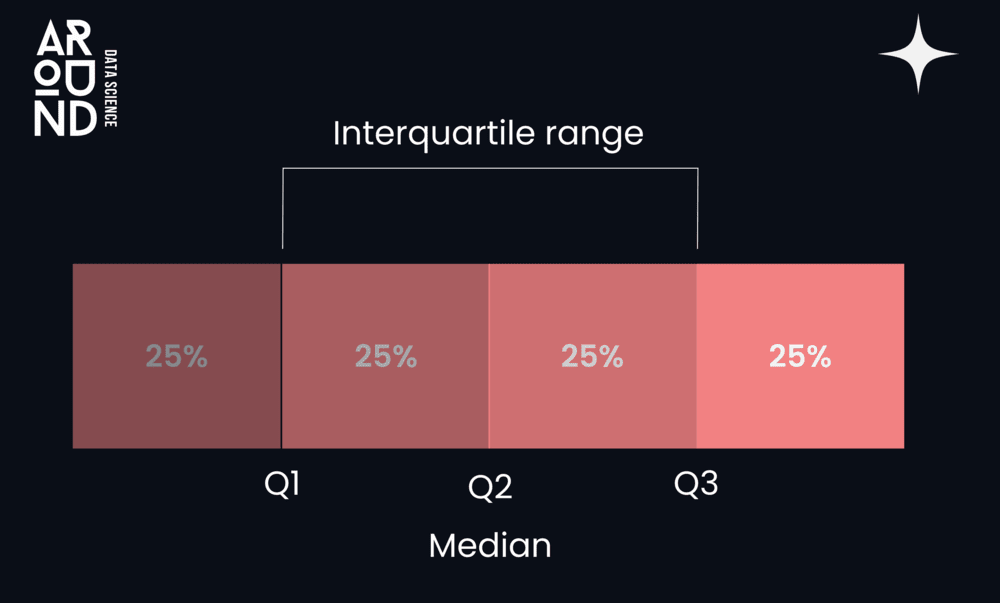As data scientists, we constantly seek ways to understand and summarize the valuable information hidden within datasets. While the mean and standard deviation are popular choices, outliers can sway them. This is where the interquartile range (IQR) steps in, offering a robust measure of variability focused on the data’s core.
What is the Interquartile Range (IQR)?
Imagine dividing your data into four equal quarters. Statisticians call these quarters quartiles, denoted as Q1, Q2, and Q3, from lowest to highest. The IQR specifically targets the spread of the middle 50% of your data, lying between the first quartile (Q1) and the third quartile (Q3).
In simple terms:
- A larger IQR signals a wider spread in your data’s core.
- A smaller IQR shows your central values are tightly clustered.
Formula:

Why Choose the IQR Over Other Spread Measures?
The IQR is a go-to tool for its robustness and versatility:
- Resistant to Outliers: Unlike the full range, which extreme values heavily influence, the IQR zooms in on the core data.
- Ideal for Skewed Distributions: Works well when the data is not normally distributed, complementing the median as a measure of central tendency.
- Intuitive Comparison: Easy to compare variability between datasets.
Step-by-Step Guide: Calculating the IQR
Here’s how to calculate the IQR manually:
- Order the data: Arrange values from smallest to largest.
- Find the median (Q2): Divide the dataset into two halves at the middle value(s).
- Identify Q1 and Q3: Locate the medians of the lower and upper halves of the data.
- Compute the IQR: Subtract Q1 from Q3.
Worked Example
Dataset:
1, 4, 8, 11, 13, 17, 19, 19, 20, 23, 24, 24, 25, 28, 29, 31, 32
Steps:
- Ordered data: Already sorted.
- Median (Q2):
- Q1: Median of lower half = 13.
- Q3: Median of upper half = 25.
- IQR:
The IQR is 12, reflecting the range of the central 50% of the data.
IQR and Real-World Applications
1. Outlier Detection:
Use the IQR to identify potential outliers:
Any data point outside these bounds is flagged as an outlier.
2. Comparing Variability:
Analyze how tightly clustered datasets are, especially in exploratory data analysis (EDA).
3. Boxplots:
Visualize the IQR in a boxplot. The box represents the IQR, while the whiskers extend up to
Finding the IQR with Tools
Most statistical tools simplify the IQR calculation. For example:
- Excel: Use
=QUARTILE.EXC(data, 1)for Q1 and=QUARTILE.EXC(data, 3)for Q3. - Python: Libraries like
numpyandpandasoffer straightforward methods to calculate quartiles and IQR.
Beyond the Basics: Exploring IQR in Boxplots
Boxplots are visual representations of data distribution that prominently feature the IQR. The box itself represents the interquartile range, with the line in the middle depicting the median.
The whiskers extend from the box towards the data points, typically reaching up to 1.5 times the IQR from the quartiles (Q1 and Q3). Any data points falling outside these whiskers are considered potential outliers and are represented by individual markers.

By analyzing boxplots, you can gain valuable insights into the data’s spread, central tendency, and potential presence of outliers. For instance, a wider box in a boxplot signifies a larger IQR, indicating a more dispersed dataset. Conversely, a narrower box suggests the data points are clustered closer together.
Conclusion: Embrace the IQR for Deeper Insights
The IQR is a reliable and insightful metric for understanding variability, especially in non-normal or outlier-prone datasets. Whether you’re performing exploratory analysis or building robust models, the IQR equips you with critical insights into your data’s core patterns.
Ready to take your data analysis skills to the next level?
We encourage you to explore more content on Around Data Science. Dive deeper into specific topics, discover cutting-edge applications, and stay updated on the latest advancements in the field.
Subscribe to our newsletter to receive regular updates and be among the first to know about exciting new resources, like our first upcoming free eBook on “Al for people in a hurry”! This comprehensive guide will demystify the world of AI and empower you to leverage its potential in your everyday life; whatever your role or background. Don’t miss out !
Welcome to a world where data reigns supreme, and together, we’ll unravel its intricate paths.




